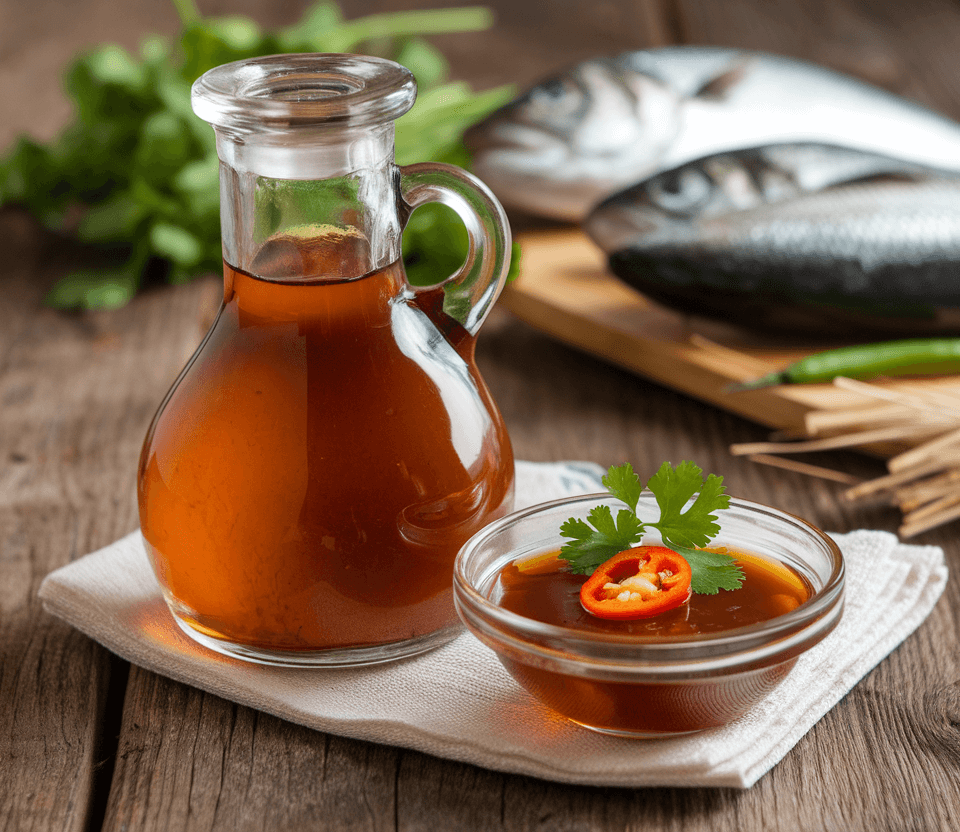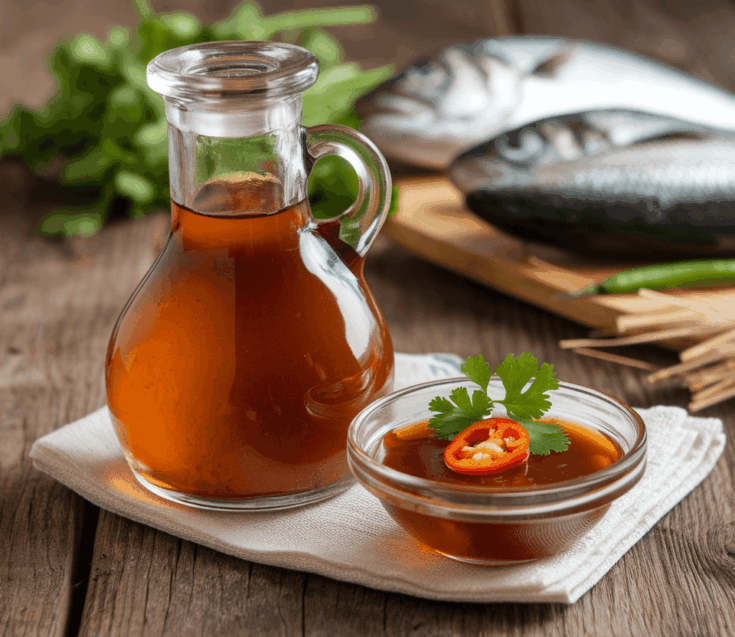Fish Sauce is a cornerstone of many Asian cuisines, renowned for its umami flavor and depth. This fish sauce recipe is easy to make at home and brings a burst of savory richness to your dishes. With just a few simple ingredients, you can create a homemade version that enhances stir-fries, marinades, and dipping sauces. The appeal lies in its authenticity and the comforting aroma that fills your kitchen as it simmers.

Why You Will Love This Recipe
You will love this fish sauce recipe for its incredible flavor and versatility. It adds a depth of umami that store-bought versions often lack, and making it at home is straightforward and rewarding. The recipe caters to various dietary preferences, allowing you to control the ingredients and avoid preservatives. Plus, it’s a fantastic way to elevate your cooking, whether you’re whipping up a quick weeknight dinner or hosting a special gathering.
Tips and Tricks
- Use fresh, high-quality fish, such as anchovies or mackerel, as they yield a more flavorful sauce.
- Ensure that your fermentation environment is clean to prevent unwanted bacteria from ruining your sauce.
- For a more complex flavor, consider adding spices like black pepper or garlic during the fermentation process.
- If you want a quicker version, you can heat the ingredients gently to speed up the infusion process, but traditional methods yield the best results.
Common Mistakes to Avoid
- Avoid using low-quality fish, as it can lead to a foul-tasting sauce.
- Don’t rush the fermentation process; good fish sauce takes time to develop its full flavor.
- Be sure to store the sauce in a cool, dark place to prevent spoilage and excessive fermentation.
- Don’t forget to strain out the solids after fermentation; leaving them in can lead to an unpleasant texture.
Make Ahead Tips
You can prepare fish sauce in advance by following the fermentation process and storing it in a glass jar. It can last in the refrigerator for up to six months. As it ages, the flavors will deepen, making it even better over time. If you’re meal prepping, consider making a large batch that will serve as a staple in various dishes throughout the week.
Recipe Variations
- For a sweeter fish sauce, add a bit of brown sugar during the cooking process.
- Experiment with different types of fish for unique flavor profiles; try using sardines or even shrimp.
- You can infuse the sauce with herbs like cilantro or basil for an aromatic twist.
- For a vegetarian alternative, consider making a mushroom-based umami sauce that mimics fish sauce.

How to Serve
Serve your homemade fish sauce as a condiment for spring rolls, grilled meats, or as a base for dipping sauces. It pairs beautifully with rice dishes, stir-fries, and salads. A drizzle of your fish sauce over a fresh vegetable salad can add a punch of flavor. For presentation, consider garnishing with chopped herbs or chili slices to enhance the visual appeal.
Pairing Suggestions
To complement your fish sauce, consider pairing it with a crisp white wine like Sauvignon Blanc or a light lager. For a non-alcoholic option, a refreshing iced green tea works beautifully. Side dishes such as jasmine rice or stir-fried vegetables will round out the meal perfectly. For dessert, a light mango sorbet can cleanse the palate after a savory meal.
How to Store
Once your fish sauce is prepared, store it in a sterilized glass bottle or jar. It can be kept in the refrigerator for up to six months. If you have leftovers, make sure to seal the container tightly to preserve flavor. When reheating, do so gently to maintain its flavor profile, as excessive heat can alter its taste.
Equipment Needed
- A glass jar or container for fermentation
- A fine-mesh strainer or cheesecloth for straining the sauce
- A saucepan for simmering (if using the quick infusion method)
- A whisk for mixing ingredients
Dietary Adaptations
For a vegan version, swap fish with fermented soy products or use seaweed to create a similar umami flavor. You can also experiment with miso paste for a rich, savory sauce. To keep it gluten-free, ensure that any soy sauce used is certified gluten-free.
Seasonal Adaptations
In summer, use fresh herbs and vegetables to enhance your fish sauce’s flavor, like basil or mint. In winter, consider using heartier ingredients, such as root vegetables or dried mushrooms, to add depth and warmth to the sauce.
Cost Breakdown
The estimated cost for making fish sauce from scratch is quite low, typically around $5 for the entire recipe, yielding several servings. If you opt for less expensive fish or buy in bulk, you can reduce costs even further. This makes it an economical choice for home cooks.
Kitchen Hacks
To peel garlic quickly, crush the cloves with the flat side of a knife, and the skins will slip off easily. If you need to chop onions without tears, chill them in the refrigerator for 30 minutes before cutting. These little tricks can help you save time and prevent messes while preparing your ingredients.

Recipe FAQs
- Can I substitute fish in this recipe? Yes, you can use different types of fish, such as sardines or shrimp.
- How long does it take to ferment? Traditional fermentation can take anywhere from 3 weeks to several months, depending on the desired flavor.
- Is it possible to make a quick version? Yes, you can heat the ingredients to infuse flavors faster, but traditional methods are recommended for the best taste.
How To Make fish sauce recipe
Fish Sauce

Fish Sauce is a cornerstone of many Asian cuisines, renowned for its umami flavor and depth.
Ingredients
- 500g anchovies or mackerel (fresh)
- 1 liter water
- 100g sea salt
- Optional: 1 tablespoon brown sugar (for sweetness)
Instructions
- Begin by cleaning the fish thoroughly, removing any guts and heads.
- In a saucepan, combine water and sea salt, stirring until the salt is dissolved.
- Place the cleaned fish in a large glass jar and pour the saltwater mixture over them.
- Seal the jar tightly and store it in a cool, dark place.
- Allow the fish to ferment for at least 3 weeks, checking periodically.
- After the fermentation period, strain the liquid through a fine-mesh strainer or cheesecloth into another container.
- Optionally, add brown sugar for sweetness and mix well.
- Transfer the finished fish sauce into a clean bottle and store in the refrigerator.
Nutrition Information
Yield
4Serving Size
1Amount Per Serving Calories 331Total Fat 16gSaturated Fat 4gTrans Fat 0gUnsaturated Fat 10gCholesterol 123mgSodium 14304mgCarbohydrates 3gFiber 0gSugar 3gProtein 41g
Easy Shrimp Recipes.com, occasionally offers nutritional information for recipes contained on this site. This information is provided as a courtesy and is an estimate only. This information comes from online calculators. Although allchickenrecipes.com attempts to provide accurate nutritional information, these figures are only estimates.
Final Thoughts
Crafting your own fish sauce is not only a rewarding culinary experience, but it also allows you to infuse your dishes with authentic flavors. This recipe is a fantastic staple that enhances a variety of meals, proving that homemade can often outshine store-bought. Enjoy the process, experiment with flavors, and relish the depth of flavor that comes from your very own kitchen creation!

